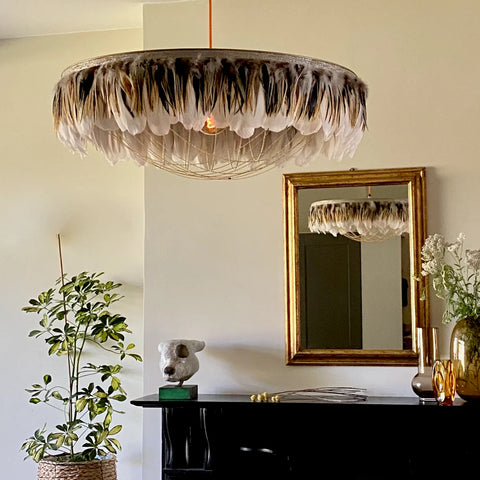
How Does Interior Design Affect Mental Health
The spaces we inhabit have a profound impact on our mental health. This is the realm where interior design and mental health intersect. Interior design is not just about aesthetics, it's about creating environments that enhance our well-being. It's about designing peaceful homes and serene spaces that nourish our mental health.
The colours we surround ourselves with can influence our mood. The amount of natural light in our homes can affect our serotonin levels. Even the arrangement of our furniture can have psychological implications.
In this article, we delve into the fascinating world of interior design and its effects on mental health. We explore how thoughtful design can create spaces that not only look good but also make us feel good. Join us as we uncover the science behind the design elements that shape our mental health. Let's discover how we can harness the power of design to create healthier, happier living spaces.
The Psychological Impact of Interior Design

Interior design is more than just creating visually pleasing spaces. It's about shaping the environment to support our mental and emotional well-being.
Principles of Interior Design
The principles of interior design can be leveraged to create spaces that promote relaxation, stimulate creativity, or foster social interaction. The choice of colours, materials, and layout can all have a significant impact on our mood and behaviour.
Organisation & Design Choices
For instance, a cluttered room can induce feelings of stress and anxiety. On the other hand, a well-organised space can promote a sense of calm and control. Similarly, the use of natural elements in design, known as biophilic design, can reduce stress and enhance mood.
Functional Space
Understanding the psychological impact of interior design can empower us to make informed decisions. It allows us to create spaces that not only meet our functional needs but also support our mental health.
Colour Schemes: Mood Modifiers in Your Living Space

Photo by Codioful (Formerly Gradienta) on Unsplash
Colours play a crucial role in shaping our emotional responses. They can evoke a wide range of emotions, from calm and relaxation to excitement and energy.
Colours and Meanings
Consider the colour blue, often associated with tranquillity and peace. Incorporating shades of blue in a living space can create a serene environment, conducive to relaxation and rest. On the other hand, vibrant colours like red or orange stimulate activity and conversation, perfect for social spaces.
Psychology of Colour
The psychology of colour also applies to creating spaces for specific purposes. For instance, green has associations with nature and growth. It can feature in a home office to promote concentration and productivity. Meanwhile, a bedroom might benefit from a soothing lavender hue, promoting restful sleep.
Learn how to colour match your interior.
Personalisation of Colours
However, it's essential to remember that colour perception can be subjective, influenced by personal experiences and cultural contexts. Therefore, it's crucial to consider individual preferences and reactions when choosing colour schemes. By doing so, we can create spaces that resonate with our emotions and contribute positively to our mental health.
Natural Light: The Serotonin Connection

Natural light is a vital element in interior design, with profound effects on our mental health. It influences our mood, sleep patterns, and overall well-being. Exposure to natural light during the day helps regulate our body's internal clock, or circadian rhythm.
What is a Circadian Rhythm?
This rhythm affects our sleep-wake cycle, hormone release, and other bodily functions. When our circadian rhythm is in sync, we're more likely to have a good night's sleep and wake up feeling refreshed.
The Power of Light
Moreover, natural light stimulates the production of serotonin, a hormone that boosts mood, calms us and focuses us. Lack of natural light, on the other hand, can lead to lower serotonin levels. This can potentially contribute to feelings of depression or anxiety.
Bring Light Into Your Interior
Therefore, incorporating ample natural light in our living spaces can enhance our mental health. You can achieve this through thoughtful window placement, use of light-reflecting colours, and careful selection of window treatments. By doing so, we can create a living environment that promotes happiness, productivity, and a sense of well-being.
Clutter and Chaos: The Stress Nexus

The state of our living environment can significantly impact our mental health. A cluttered, disorganised space can contribute to feelings of stress and anxiety.
Stress and Reduced Productivity
Research suggests that clutter overloads our senses, making us feel overwhelmed. It can also make it more difficult to relax, both physically and mentally. Furthermore, clutter can hinder productivity by distracting us and making it harder to focus on tasks.
Decluttering
By maintaining a clean, organised living space, we can reduce stress and create a more peaceful home. This involves regular decluttering, efficient storage solutions, and mindful purchasing habits. Through these practices, we can create a serene space that promotes mental well-being.
Personal Space and Privacy: Sanctuaries for the Mind

It's hard to overstate the importance of personal space and privacy in residential design. Having a private sanctuary where one can retreat and recharge is crucial for mental health.
Designing Your Personal Space
A well-designed personal space can provide a sense of security and control, reducing feelings of stress and anxiety. It allows for self-reflection, relaxation, and the pursuit of personal interests without interruption.
Benefits of Personal Space
Incorporating elements that reflect personal tastes and values can enhance the sense of ownership and comfort in these spaces. By creating a personal sanctuary, we can foster a sense of well-being and peace in our homes.
Biophilic Design: Nature's Embrace in Urban Dwellings

Biophilic design principles are gaining traction in the world of interior design. This approach seeks to connect occupants with nature, even in the most urban of settings.
Reducing Stress
Incorporating elements of nature into our living spaces can have profound effects on our mental health. Research shows that exposure to natural elements can reduce stress, enhance mood, and improve cognitive function.
Natural Materials
We can achieve this through the use of natural materials, the inclusion of plants, feathers, and the creation of views to the outside world. Even the use of nature-inspired patterns and colours can evoke a sense of calm and well-being.
Using Feathers
The feathers we use on our lights shades and chandeliers bring another natural element into the home. The way our shades seem to float in mid air takes our gaze upwards and connects us to the animal kingdom. In particular, to the idea of birds in flight.
Biophilic design is not just about aesthetics. It's about creating living spaces that nourish the mind and soul, promoting a healthier and happier life.
Ergonomics and Comfort: Easing the Body to Soothe the Mind

Photo by Ajay Karpur on Unsplash
Ergonomics plays a crucial role in interior design, directly impacting our physical comfort and, consequently, our mental health. The design and arrangement of furniture can either contribute to or alleviate physical strain and fatigue.
Supporting Your Body
An ergonomic design prioritises the human-body interaction with the environment. It ensures that furniture and other elements of a room support our body's natural posture. This reduces the risk of discomfort, pain, and physical stress, which can lead to mental fatigue and anxiety.
Improving Your Daily Life
In essence, a well-designed, ergonomic space can enhance our overall well-being. It allows us to perform daily tasks with ease. Contributing to a sense of satisfaction and peace in our living environment.
Scent and Sensibility: Olfactory Influences on Emotion
The olfactory elements of a space, often overlooked, can significantly influence our emotional states. Certain scents can trigger memories, evoke emotions, and even alter our mood.
The Power of Smell
For instance, the scent of lavender can induce relaxation, while citrus fragrances can energise and uplift. You can Incorporate these elements into interior design, through candles, essential oils, or even certain plants. This creates a more emotionally balanced environment.
Acoustics and Soundscapes: The Auditory Aesthetics of Peace
The soundscape of a space, much like its visual and olfactory elements, can significantly impact our mental state. Noise pollution, for instance, can lead to increased stress levels and cognitive fatigue.
The Use of Sound
Using nice sounds, such as soft music or the gentle trickle of a water, can help relaxation and mental well-being. Furthermore, the use of sound-absorbing materials in interior design can help create a quieter, more peaceful environment.
Creating Mindfulness
In essence, mindful consideration of acoustics and soundscapes in interior design can contribute to your space. Creating serene spaces that promote mental health.
Healing Architecture: Therapeutic Environmental Design
Healing architecture is a concept that emphasises the role of the built environment in promoting health and well-being. It is a design approach that considers the psychological impact of architectural elements and aims to create therapeutic environments.
Use of Building Materials
For instance, the use of natural materials, access to outdoor views can all contribute to a sense of calm and well-being. Similarly, the design of spaces that promote social interaction can help mitigate feelings of isolation and loneliness.
Holistic Approach
In conclusion, healing architecture represents a holistic approach to interior design. Where the focus is not just on aesthetics, but also on the mental health benefits that the design can provide.
Conclusion: Harmonizing Interior Design with Mental Well-Being
In conclusion, the impact of interior design on mental health is profound and multifaceted. From the colours we choose for our walls to the amount of natural light we let in. Every design decision can influence our mood, stress levels, and overall mental well-being.
By understanding these connections and applying principles of therapeutic design. We can create living spaces that not only look good but also support our mental health. This harmonisation of interior design with mental well-being is an essential step towards creating mindful space. Creating healthier, happier homes and communities.




